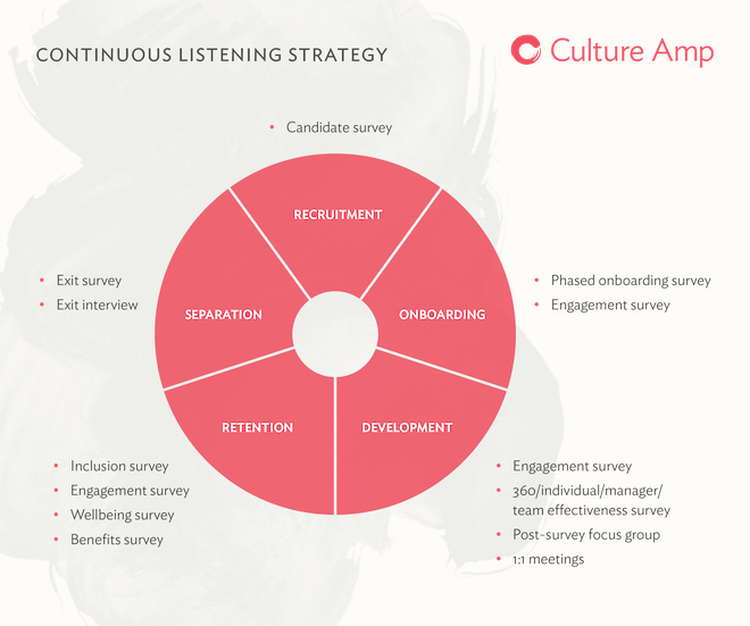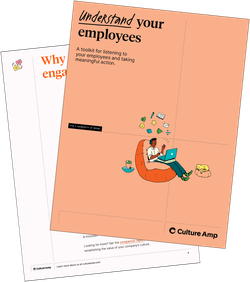
Continuous listening strategy: What it means & why it matters

HR and People strategies are always evolving. We’re far from the days of traditional annual surveys, and more companies are starting to embrace the idea of a continuous listening strategy. Similar to building a culture of feedback, continuous listening means gathering feedback more often across the employee lifecycle.
Here, we’ll explore the definition of continuous listening strategy, how it’s enabled by technology and in-person feedback, how companies have found success with frequent feedback, and how you can get started.
What is a continuous listening strategy?
A continuous listening strategy is the practice of gathering feedback more often across the employee lifecycle. This doesn’t necessarily mean more pulse surveys. Employee feedback can be collected on a large scale via employee surveys, and results should be gathered in real time with appropriate actions taken based on the data. In-person feedback conversations are also vital to creating a sustainable continuous listening strategy.

What a continuous listening strategy is not
Continuous listening doesn't mean surveying every week or every month. Collecting feedback so frequently makes it hard to take meaningful action. When employees give their feedback and see that nothing is done, they will start to lose faith in the feedback process.
Bottom line: don’t ask questions you’re not ready to take action on, and only survey as frequently as you can act. There is an art to listening to your employees, so be thoughtful and considerate when designing your strategy.
How does technology play a role in continuous listening?
Employee surveys administered online are fast and easy to execute. With online surveys, employees anywhere in the world can be assured that their voice is heard. Technology has also opened the way for surveys that go beyond employee engagement. Surveys that cover onboarding, manager 180, candidate experience, and more are available to HR leaders.
Here are additional survey types for your strategy:
- Employee engagement survey
- Onboarding survey
- Exit survey
- Candidate experience survey
- Company values survey
- Wellbeing survey
- Inclusion survey
- Benefits survey
- 360 individual effectiveness survey
- Manager effectiveness survey
- Team effectiveness survey
In-person components of a continuous listening strategy
In addition to surveys that allow you to collect feedback at scale, in-person listening and gathering feedback are essential. A great example of invaluable in-person feedback is 1-on-1 meetings between managers and direct reports. Chloe Hamman, Director of People Science at Culture Amp, says, “Effective 1-on-1s circulate through a variety of topics over time, depending on what’s going on in your organization and for the individual.”
Effective one-on-ones circulate through a variety of topics over time, depending on what’s going on in your organization and for the individual.
Chloe Hamman
Director of People Science at Culture Amp
Another great way to gather feedback in person is through post-survey focus groups. Once you’ve closed a survey and communicated results, choose a focus area to discuss with employees. Bringing them into action planning sessions in this way keeps them involved in the continuous listening strategy process. “How might we” sessions where the focus area is phrased as a question are another great way to get employees involved. An example is a "How might we increase diversity in hiring?" session.
Continuous listening requires taking action
A continuous listening strategy will fail if you listen to feedback and then do nothing. The point of collecting feedback more often across the employee lifecycle is that it enables you to take targeted action. For example, a candidate survey provides you feedback on the candidate experience that you would not likely get elsewhere. You can take that feedback and improve the recruiting process, leading to better hiring.
While it may seem overwhelming to view the components of a continuous listening strategy piece by piece, mapping them along the employee lifecycle can help you decide when to launch specific surveys or plan in-person feedback sessions.
Examples of successful continuous listening strategies
One of the best ways to understand a continuous listening strategy in practice is through real-world examples. Here are a few examples of how moving to more frequent feedback led to better business outcomes.
Envato
James Law, HR Consultant at Envato, says the company “dipped their toe” into engagement surveys through a “rudimentary” Google form. After this attempt, they used the "Great Place to Work" study, which provided an annual snapshot of how people at Envato felt. However, for James, that was an issue. “It gave us a really good snapshot, but it only gave us a view of one point in time, annually. Everyone knows that business moves quicker than that.” By switching to a more robust survey platform, Envato can collect more feedback over time. Their first engagement survey prompted them to put a fully flexible work environment and monitor reactions over time through follow-up surveys.
Mercy Health
Mercy Health had previous experience with vendors such as Advisory Board, Gallup, and Press Ganey. Kyle Arnold, Systems Director of People Analytics and Talent, says, “We were paying a large amount of money for an annual survey that was slow to deliver insights - and our team still had to do the majority of the lifting.” Mercy Health ran six employee experience surveys on the Culture Amp platform in less than a year. The insights have been used to improve their Medical Residency and Performance Management programs. “These improvements deliver a better employee experience, so we know employees will be happier, the culture will be better, they'll ultimately perform better, and productivity goes up,” said Kyle.
TP ICAP
TP ICAP continually leverages the Culture Amp platform to drive cultural change. “Our culture has continued its evolution, and it’s critical that employees feel like they have a say. This means we’re using Culture Amp to capture feedback across the employee experience from our joiners and leavers in our annual engagement survey, and now the 360 reviews to develop individual talent,” explains Louise Dilworth, the Group Head of Performance & Engagement.
Creating and executing your continuous listening strategy
While there are many components to a continuous listening strategy, the most important one is how you will get started. Whether you see the greatest need through an employee experience survey like onboarding or want to dive in with a quarterly engagement survey, getting started is a step in the right direction.
Set yourself up for success by having a plan of action, mapping your surveys for the year, and embracing in-person feedback across the employee lifecycle. See where you have opportunities to get more data and make sure people are comfortable with how that data is being used. When you’re ready, Culture Amp is here to help set you up for success.





